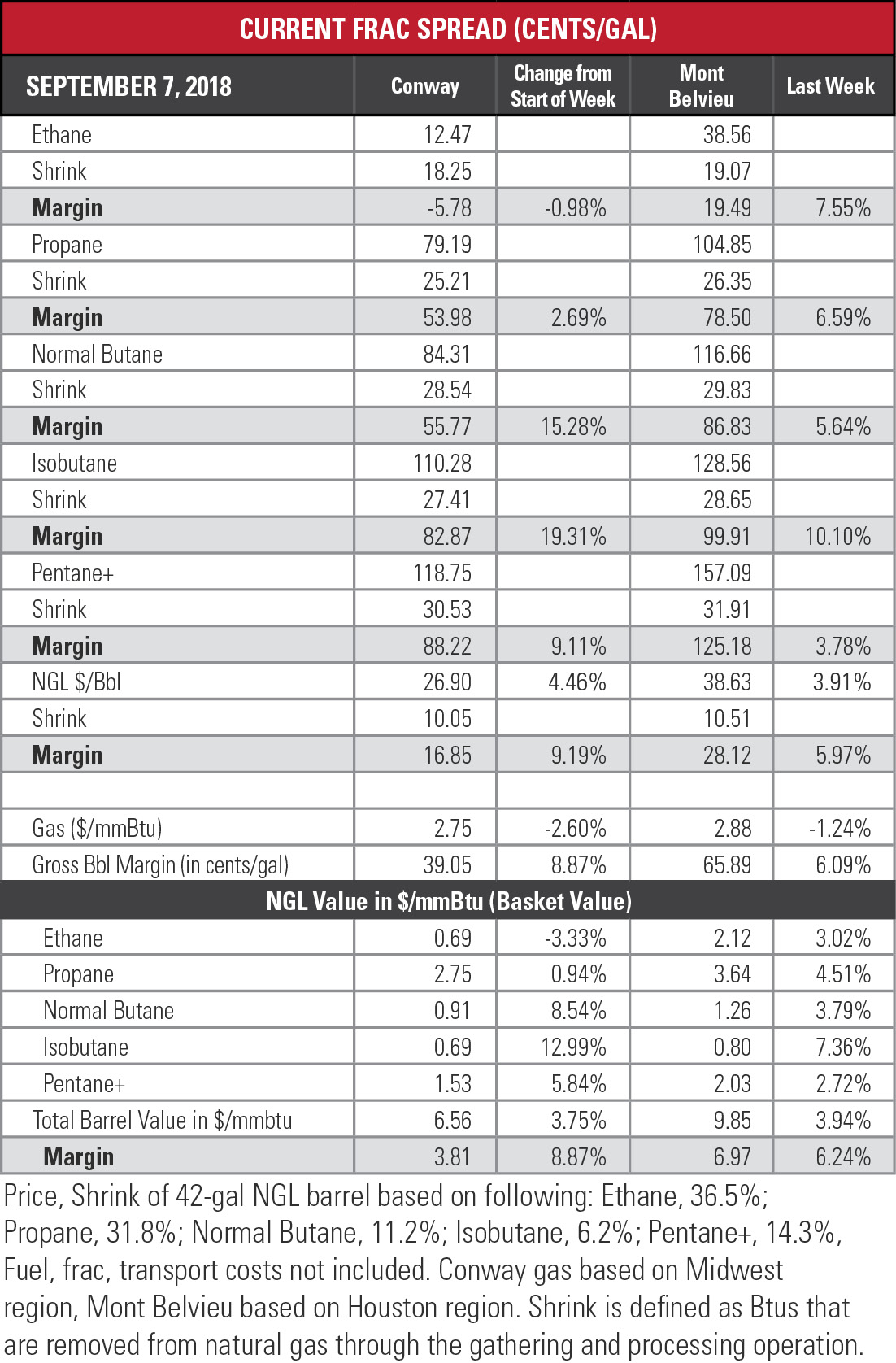
Ethane continued its march toward 40 cents per gallon (gal) and the Mont Belvieu, Texas, hypothetical NGL barrel broke through $38 for the first time in 47 months in a holiday-shortened four-day week.
Higher demand from domestic crackers and rising exports have strained inventories and continue to push ethane’s price upward. Mont Belvieu ethane is up 83.2% for 2018, 45.7% since the end of the first quarter and 55.5% ahead of what it was last year at this time. Last week’s margin grew by another 7.55% to 19.49 cents/gal.
 The U.S. Energy Information Administration’s (EIA) latest data, released Aug. 31, show total U.S. stocks of ethane and ethylene declining by about 9% from January through June to 46.7 million barrels. The one-year decline is 9.7%.
The U.S. Energy Information Administration’s (EIA) latest data, released Aug. 31, show total U.S. stocks of ethane and ethylene declining by about 9% from January through June to 46.7 million barrels. The one-year decline is 9.7%.
Propane also rose last week, posting a 4.5% increase for another 2018 high a week after breaking through $1/gal. Price increases have tended to curtail exports in the past, leading to canceled cargoes as foreign buyers pivot to naphtha.
But in contrast to ethane demand, which resulted in a dip into inventory, EIA data show U.S. propane stocks expanding by almost 19% from January through June. The June 2018 figure was little changed from June 2017, but the increase from January last year was less than 3%.
 However, U.S. total propane inventories for June 2018 are 29.6% below the figure in June 2016.
However, U.S. total propane inventories for June 2018 are 29.6% below the figure in June 2016.
Mont Belvieu butane rose to its second-highest level of the year, exceeded only by the $1.23/gal at the end of July. In fact, outside of July, it was the second-highest price since February 2017. That put last week’s butane’s price 27% over where it was in 2017 at this time and 96% above the price at this time in 2016.
Isobutane’s margin widened by 10.1% last week to almost $1/gal as its Mont Belvieu price increased by 7.4%. Isobutane is 34.4% higher than it was at this time in 2017.
Natural gasoline returned to near its peak for the year, experienced in May. The price was 43% above what it was a year ago and 70% higher than the price of 92.52 cents/gal at this time in 2016.
In the week ended Aug. 31, storage of natural gas in the Lower 48 experienced an increase of 63 billion cubic feet (Bcf), the EIA reported. The figure, compared the Bloomberg survey’s consensus average of 60 Bcf, resulted in a total of 2.568 trillion cubic feet (Tcf). That is 20% below the 3.211 Tcf figure at the same time in 2017 and 18.7% below the five-year average of 3.158 Tcf.
 Joseph Markman can be reached at jmarkman@hartenergy.com or @JHMarkman.
Joseph Markman can be reached at jmarkman@hartenergy.com or @JHMarkman.
Recommended Reading
Texas Gas Vital to Mexico’s Nearshoring Boom
2024-10-25 - Continued U.S. piped-gas exports to Mexico bode well for Eagle Ford and Permian producers.
Commentary: Maximizing the Opportunity for Energy Dominance
2024-12-18 - Energy produced in the U.S. already has a strong grip on global markets. But with the country on the cusp of a new regulatory environment, will the U.S. capitalize on the opportunity to maximize energy dominance?
Analysts: DOE’s LNG Study Will Result in Few Policy Changes
2024-12-18 - However, the Department of Energy’s most recent report will likely be used in lawsuits against ongoing and future LNG export facilities.
Dell: Folly of the Forecast—Why DOE’s LNG Study Will Invariably Be Wrong
2025-01-07 - Kimmeridge’s Ben Dell says the Department of Energy’s premise that increased LNG exports will raise domestic natural gas prices ignores a market full of surprises.
Hirs: Expansive Energy Policies Set to Shape 2025 Markets
2025-01-02 - The incoming administration’s policies on sanctions, tariffs, regulations and deportations will impact the oil and gas industry.
Comments
Add new comment
This conversation is moderated according to Hart Energy community rules. Please read the rules before joining the discussion. If you’re experiencing any technical problems, please contact our customer care team.






